On September 23, 1887, eminent ornithologist Ludwig Kumlien climbed the 60-meter-tall tower adorning Milwaukee’s new architectural landmark, the Industrial Exposition Building. It was the perfect vantage point to watch for migrating birds, but Kumlien was there for a different reason: Milwaukee’s pride and joy was proving an avian death trap.
From early evening until almost midnight, the tower was lit up by four electric floodlights, creating a dazzling beacon in an otherwise dark sky. Birds heading south for winter were drawn in and died as they flew into wires, windows and each other. Kumlien’s report of the daily death toll was the first scientific account of the ecological downside of lighting up the night sky.
The world is steadily losing the deep dark of nighttime. In the second half of the twentieth century, the artificially illuminated area of the world grew by up to 6 percent a year, and a 2017 analysis of satellite data shows it’s still expanding by 2.2 percent each year, and getting brighter. Some 83 percent of the human population lives under light-polluted skies. A third of the world’s population can’t see the Milky Way.
Astronomers and stargazers have long campaigned for a return to darker skies. Now it’s the turn of ecologists, alarmed by the toll on birds, moths and other insects lured to their deaths; by animals no longer able to navigate; by night foragers afraid to go out at night; and by creatures that use light to communicate but are unable to transmit their messages.
While we enjoy the benefits of well-lit homes, towns and cities, artificial illumination is exacting an unexpectedly high price from plants, animals and ecosystems that evolved when days were light, nights were dark and the age-old cycles of illumination were predictable.
That price is set to rise, ecologists warn. Unlike older-style, orange-glowing lamps, which emit light from a narrow part of the spectrum, the brighter, whiter light-emitting diodes (LEDs) that are fast replacing them emit light across the spectrum, with a peak in the blue region — the most wildlife-unfriendly light of all. And artificial light of unnatural intensity and color is encroaching ever farther into remote wildlands and out over unlit oceans, thanks to skyglow, the diffuse pall created as upward-shining light from towns and cities is scattered by dust, water and gas molecules in the atmosphere. An estimated 23 percent of the world’s land area now experiences skyglow.
Artificial nighttime light is now one of the hottest topics in ecology, with an explosion of research aimed at pinning down and quantifying its ecological effects. Thanks to systematic long-term field studies, remote monitoring and manipulative experiments, almost every week brings revelations about how the wrong sort of light in the wrong place at the wrong time is affecting wildlife from microbes to moths to mammals, on land, in rivers and at sea. “It’s a very widespread and intense environmental pressure that’s evolutionarily very novel, and that makes it particularly challenging for organisms,” says urban ecologist Kevin Gaston of the University of Exeter in southwest England. “Only now is the breadth of effects becoming apparent.”
Good-bye darkness, my old friend
Wholesale transformation of the nighttime environment began almost as soon as Thomas Edison sold his first lightbulb. Today, urban areas are ablaze with light from streetlamps (around 300 million worldwide and rising), illuminated buildings and billboards, floodlights, highway lighting and vehicle headlamps. Beyond city limits, skyglow is fainter but can outshine the stars and mask the phases of the moon. In urban areas, on cloudy nights when skyglow is reflected back to Earth, the night sky can be thousands of times brighter than it would be naturally — the opposite of how things were in the past, when cloudy nights were the darkest nights.
“You can see the glow from Los Angeles and Las Vegas from the Sierra Nevada 300 kilometers away,” says Travis Longcore, an urban ecologist at the University of Southern California and science director of the Urban Wildlands Group, a Los Angeles-based nonprofit organization.
Concerns about nighttime light go back at least a century, prompted initially by the obvious toll as disoriented birds flew into buildings and, later, by the sight of confused sea turtle hatchlings turning their backs on the sea and heading toward the twinkling lights of beachfront bars. Soon scientists began to worry about where some of the less dramatic changes they observed might be leading: What upsets might follow when daytime animals foraged well after twilight and nocturnal ones set out later, when the dawn chorus began hours before dawn, or when trees blossomed early or shed their leaves later? As biologists notched up ever more such observations, lab studies were steadily detailing the role of light in physiological processes, including sleep and metabolism, essential nighttime repairs, germination and flowering.
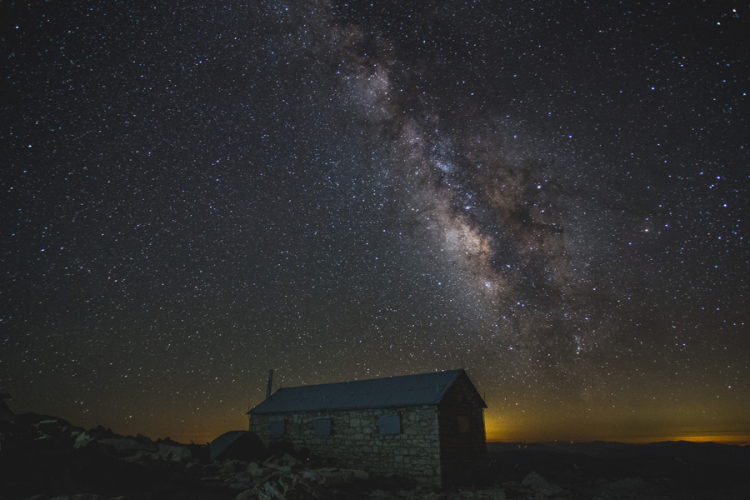
A view from Mt. Whitney in California, showing skyglow from Los Angeles on the horizon. Skyglow can extend hundreds of kilometers from the source, encroaching on wildlands.
CREDIT: BENJAMIN BANET
Today, with a better understanding of the scale of light pollution and more sophisticated technology, researchers are investigating in new ways and places and finding that the obvious direct effects — say, the millions of moths picked off by bats as they fly around streetlights, or the fireflies unable to attract mates — may be dwarfed by the impacts of nighttime light on biological timings. Life, after all, evolved under natural cycles of illumination — the daily rising and setting of the sun, the monthly waxing and waning of the moon, and seasonal changes in the length of the day. As the most predictable fluctuations in the natural environment, these cycles are the most important cues for numerous activities and biological processes.
Confusing times
Some of the earliest clues that city lights upset biological rhythms came from studies of birds. In temperate regions, songbirds time reproduction so that there’s plenty of suitable food for their chicks: The lengthening days in the run-up to spring prompt physiological changes that trigger the growth and maturation of gonads, and breeding behavior. Most urban backyard birdwatchers have witnessed city birds hatching young weeks before their country kin. And most have heard birds singing long before dawn. Biologists reckoned that artificial light was altering the birds’ perception of time and season, though they couldn’t rule out other features of city life such as warmer temperatures and different foods.
Through a series of studies starting in 2009, Italian ecologist Davide Dominoni produced evidence that light is, indeed, the culprit, and that it doesn’t take much of it to spark profound changes. At the time, Dominoni was based at Germany’s Max Planck Institute for Ornithology, where he focused on a common European species, the blackbird (Turdus merula). He began by fitting miniature light loggers to birds in Munich and birds from a nearby forest, and saw from the logger data that while urban birds are exposed to significantly higher levels of light, it’s nowhere near the amount illuminating city streets. “That suggests birds actively try to avoid bright spots when they sleep,” he says.
Dominoni then exposed captive male blackbirds to that same low level of light at night, and found they developed functional testes 26 days earlier, on average, than birds kept in the dark. At the height of spring, they also began singing up to 2 hours before the pre-dawn twilight.
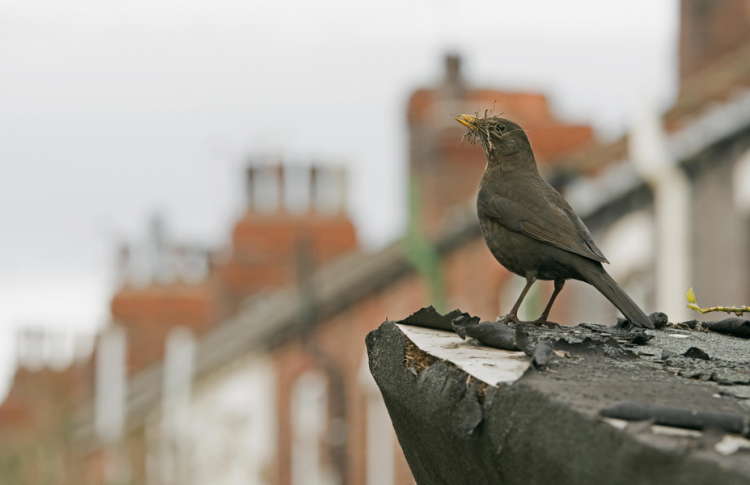
Blackbird in the city. Birdwatchers have long observed city birds singing far before dawn and rearing young earlier than birds in the countryside. Experiments are verifying these effects and linking them to light pollution.
CREDIT: FLPA / ALAMY STOCK PHOTO
From this it wasn’t yet clear whether artificial light alters the birds’ perception of when the day starts and ends, and thus what time of year they think it is. To get at this, Dominoni fitted city and country blackbirds with mini-backpacks, each containing a light logger and a radio transmitter, and released them. The devices recorded when the birds became active and when they retired for the night. The difference was striking: In March, a city bird’s “day” was on average 62 minutes longer than a country bird’s, the equivalent of advancing spring by 19 days — a highly suggestive match with the results with captive birds and earlier findings that city blackbirds are ready to reproduce 19 days earlier than rural ones.
Do urban birds pay a price for this? “In the short term, there might be benefits because they can forage longer,” says Dominoni. But birds that breed early could find themselves at risk of predation or out of synch with the supply of insect larvae their chicks need to thrive, he adds, though he doesn’t yet have data on that.
Though studies with captive animals offer important insights, it’s much harder to document what matters the most: how light affects animals in the wild. But a groundbreaking Australian study by reproductive ecologist Kylie Robert of La Trobe University in Melbourne, did just that — showing for the first time how light pollution might jeopardize survival of a large indigenous mammal by wrecking its meticulously timed reproductive schedule.
Robert had access to a natural laboratory: Garden Island off the coast of Western Australia, home to Australia’s largest naval base and to two populations of the nocturnal tammar wallaby (Macropus eugenii). One population lives in native bush, where the only light at night is celestial. The other is confined to the naval base, exposed to light that’s orders of magnitude more intense.
Tammar wallabies normally breed like clockwork, giving birth around six weeks after the summer solstice. This ensures that by the following spring, when the young require most milk, food for their mothers is at its most abundant.
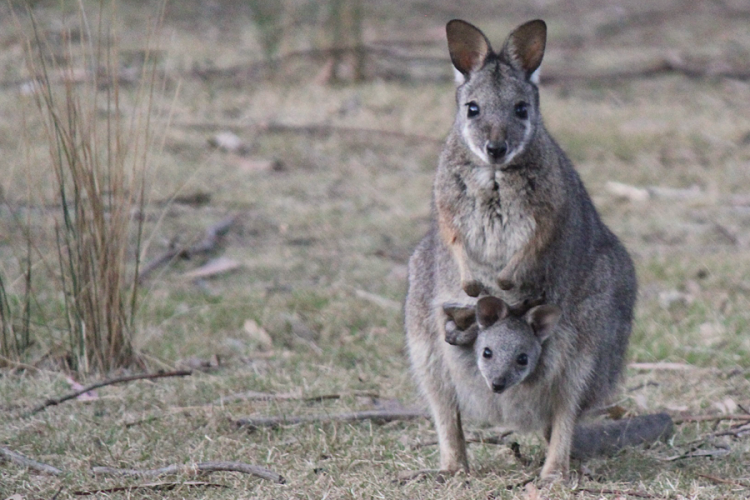
A Tammar wallaby. Wallabies living on a naval base and exposed to night-time illumination gave birth a month later than those in the bush, Australian scientists found.
CREDIT: KYLIE ROBERT
For five years Robert and her team recorded when the wallabies gave birth. They also took blood samples to monitor nighttime levels of the hormone melatonin, which regulates the body’s internal timekeeper and controls the seasonal changes in reproductive physiology that ensure wallabies stick to schedule. Production of melatonin increases during the night and lab studies have shown that artificial light is a potent suppressor of melatonin in a wide range of animals.
The team found that wallabies on the naval base gave birth a month later than those in the bush — putting them out of synch with the natural cycle of food supply and threatening the survival of young. “When times are tough, mothers will abandon their young. It’s something they have evolved to do,” says Robert. Records of the number of offspring weaned successfully from 2005 to 2013 hint at trouble. “There seems to have been a decline each year with the exception of 2010,” Robert says.
Blood analysis confirmed that on the base the wallabies’ timekeeping slipped because they didn’t produce enough melatonin to keep the clock running smoothly. Their nighttime concentration of melatonin was less than half that of the bush wallabies, about the level expected for daytime. “This shows that the delayed birth dates are directly related to the illumination of the base at night,” says Robert. “The same effect will be found in many other seasonally breeding mammals…. This is just the first we’ve found out about.”
For many marine creatures, the crucial cue that it’s time to reproduce comes not from sunlight, but moonlight. In one of the most synchronized events in nature, many corals on Australia’s Great Barrier Reef spawn on the same night, a strategy to improve their chances of reproductive success. So what happens when the lunar cycle is masked by unnatural light?
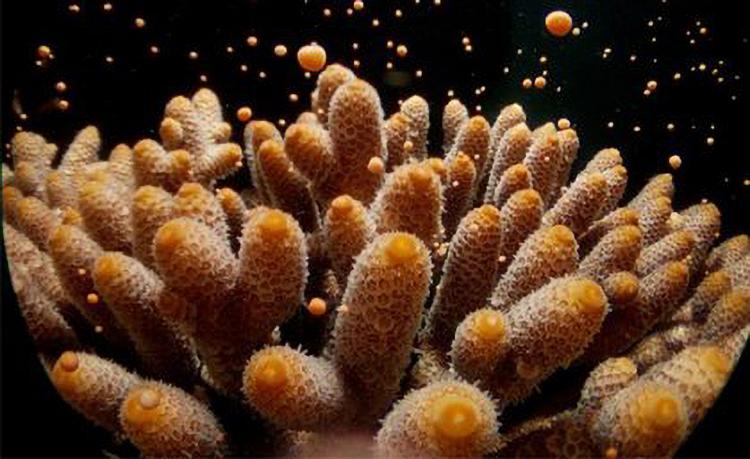
Many species of coral at Australia’s Great Barrier Reef spawn on the same night. Studies with the coral species Acropora millepora (shown here releasing its gametes) reveal that illumination at night disrupts this process.
CREDIT: COURTESY OF PAULINA KANIEWSKA
In 2011, coral biologist Paulina Kaniewska from the University of Queensland and neurobiologist Shahar Alon, then at Tel Aviv University, carried out a unique series of experiments on the reef-building coral Acropora millepora. They collected coral colonies from the Heron Island reef flat and installed them in outdoor aquariums with seawater flowing through. By exposing colonies to different light treatments, they discovered that light changes gene activity and cell-signaling processes that are linked to the release of eggs and sperm — changes that happen only on the big night.
Curious about the effect of light pollution, for eight nights in the run-up to spawning the team exposed some colonies to low-intensity artificial light for six hours after sunset. The result left them convinced that light pollution could be disastrous for corals. Unlit colonies spawned on cue. The illuminated ones — full of gametes and good to go — failed to spawn at all.
Wallabies, birds and corals are high-profile creatures. But Gaston and fellow ecologists at the University of Exeter concern themselves with less glamorous, unobtrusive organisms, the sort we often ignore. Their long-term field studies of plants and invertebrates have spotted changes that are likely happening everywhere there is artificial light. Night light advances leafing by more than a week in common UK trees such as beech, oak and ash; it shifts some plants’ flowering times, with repercussions for both plants and the animals that exploit them; and it changes the composition of grassland vegetation and invertebrate communities.
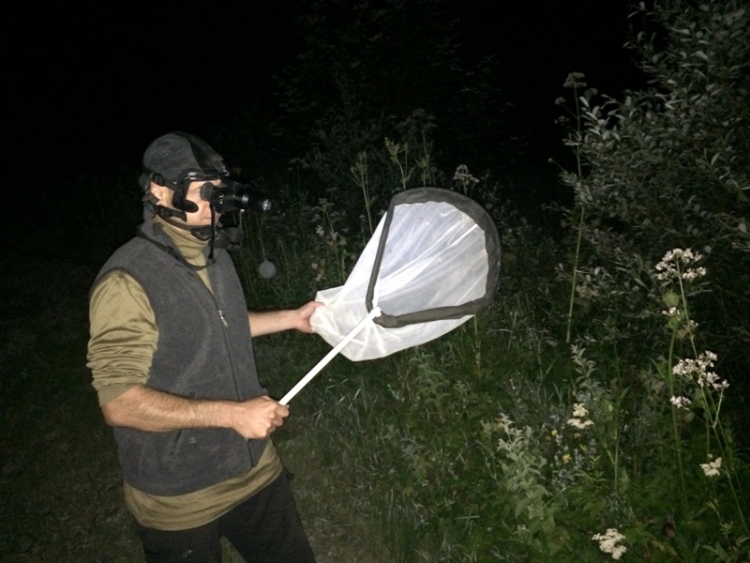
A Swiss scientist wearing night-vision goggles catches bugs, beetles and moths visiting Alpine meadow flowers at night.
CREDIT: SIMONE GIAVI/UNIVERSITY OF BERN
In one study in the Cornish town of Helston, Gaston’s team sank traps into grassy vegetation beneath traditional sodium streetlights and in darker spots between, and found they captured different mixes of invertebrates. Carnivores — predators such as spiders, ants and beetles, and scavengers such as wood lice and amphipods — were far more numerous directly under the lights.
Then, as part of a larger, three-year field experiment on Cornwall’s Lizard Peninsula, the team introduced white LED lighting to a previously unlit area of grassland. Again, spiders and beetles became more abundant — but only certain species. “Such changes are restructuring communities in novel ways, with implications for how they function and the services they provide,” Gaston says.
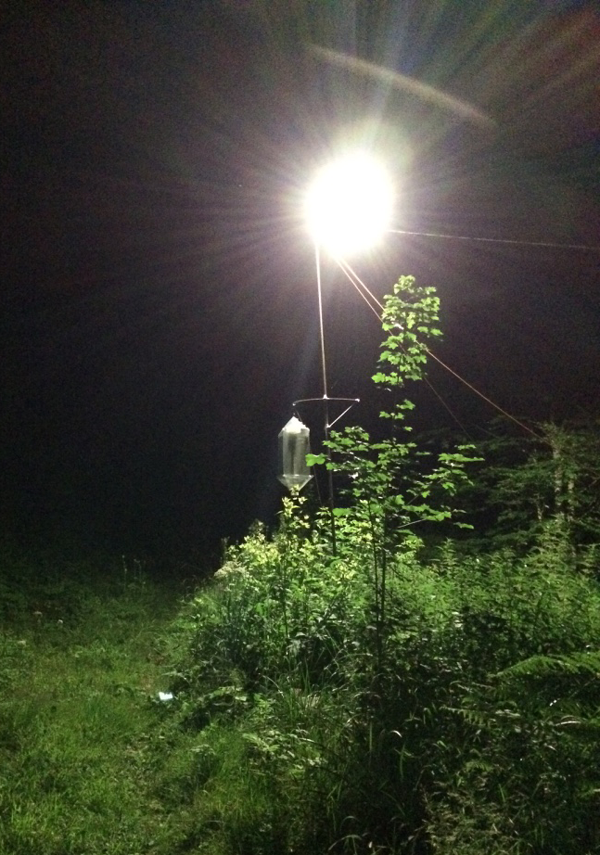
To test the effects of artificial light at night, Swiss scientists installed mobile street lamps with LED lamps in remote Alpine meadows, and measured the impact on nocturnal pollinators.
CREDIT: SIMONE GIAVI/UNIVERSITY OF BERN
One crucial service is pollination, and there’s powerful new evidence showing that light pollution compromises it. Last year, Swiss ecologist Eva Knop from the University of Bern reported that the introduction of artificial light to remote alpine meadows caused a dramatic fall in the number of moths, bugs and beetles visiting meadow flowers at night.
Knop had led a team to the foothills of the Alps, where they installed mobile street lights lit by white LEDs, of the type increasingly used for public street lighting, in meadows far removed from other light sources. Wearing night-vision goggles, they monitored activity of nocturnal insects in seven lit and seven unlit meadows. Under the streetlamps, flowers received 62 per cent fewer insect visits. Some insects were attracted to the lights rather than flowers; others seemed to sit about doing nothing at all.
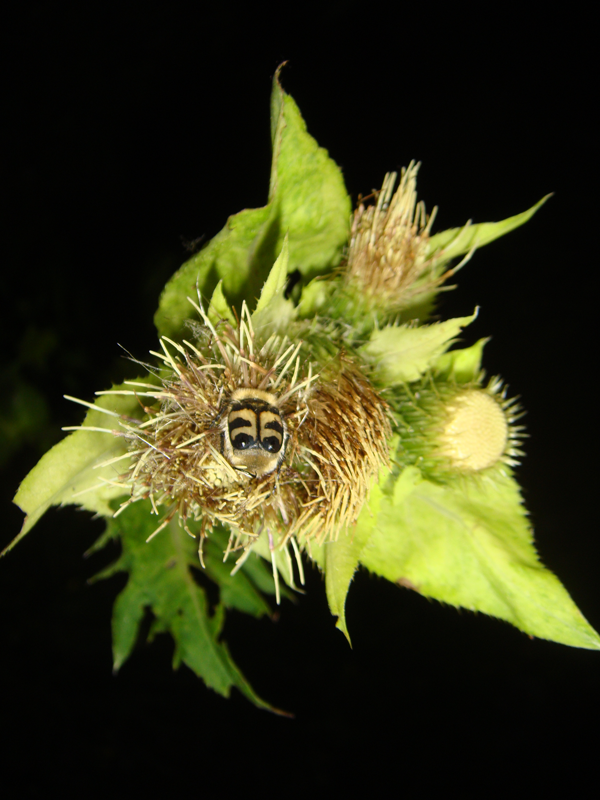
At night, cabbage thistles (Cirsium oleraceum) are visited by beetles and other nocturnal pollinators. In experiments, artificial light reduced the number of insect visitors, leading to a reduced fruit set.
CREDIT: EVA KNOP/UNIVERSITY OF BERN
Knop also found that despite plenty of visits by bees, butterflies and other day-flying pollinators, the nightly no-shows made a big dent in the reproductive success of at least one key meadow plant, the cabbage thistle (Cirsium oleraceum), which set 13 percent fewer fruits. A busy day shift, she concluded, can’t compensate for downsizing the night shift. The implications for pollinators and plants alike are potentially serious, she says. For plants that depend wholly on insects for pollination, fewer visitors will shrink populations. For plants able to self-pollinate — like the cabbage thistle — fewer visiting insects mean less cross-pollination, which leads in turn to a loss of genetic variation and a greater risk of extinction. Either way, fewer plants mean less food for insects, whether they’re active by night or day.
Unhealthy glow
Despite a proliferation of studies, hardly any address the dimmer, reflected light of skyglow. But ecologists feel sure that it exerts an influence, and far beyond urban areas. Many animals are more active on dark moonless nights, when it’s easier to avoid predators. Other creatures use starlight to navigate. Some 30 percent of all vertebrates and 60 percent of invertebrates are active by night and are super-sensitive to light. And even diffuse, low-intensity skyglow is enough to interfere with many biological processes. “We have a lot of knowledge on the influence of lunar cycles on wildlife and we know that skyglow can be many times brighter than the full moon,” says Longcore.
Testing skyglow’s effects is tricky, however, not least because of the difficulty of reproducing it for experiments. And as luck would have it, the organisms ecologists want to study first — zooplankton — live in challenging places to work in.
Freshwater and marine zooplankton spend their days at depth to avoid predators; at night, guided by moonlight and starlight, they migrate upward to feed on algae near the surface. This daily migration is the most widespread and synchronized movement of biomass on the planet, and each year, these tiny animals capture and transport millions of tons of carbon to the depths.
Back in 2000, US researchers reported that Daphnia water fleas in Lake Waban near Boston responded to artificial light by shortening their daily migration by 2 meters. Now a German team, led by ecohydrologist Franz Hölker of the Leibniz Institute of Freshwater Ecology and Inland Fisheries, is testing whether skyglow has a similar effect on zooplankton in Lake Stechlin, a deep, dark, lake north of Berlin. The study hinges on the existence of LakeLab, an experimental array of 24 freshwater tubes stretching from the lake bed to its surface. By exposing six of these to varying levels of artificial skyglow and videoing the movement of plankton, the team hopes to learn if — and how — skyglow affects the nightly migration.
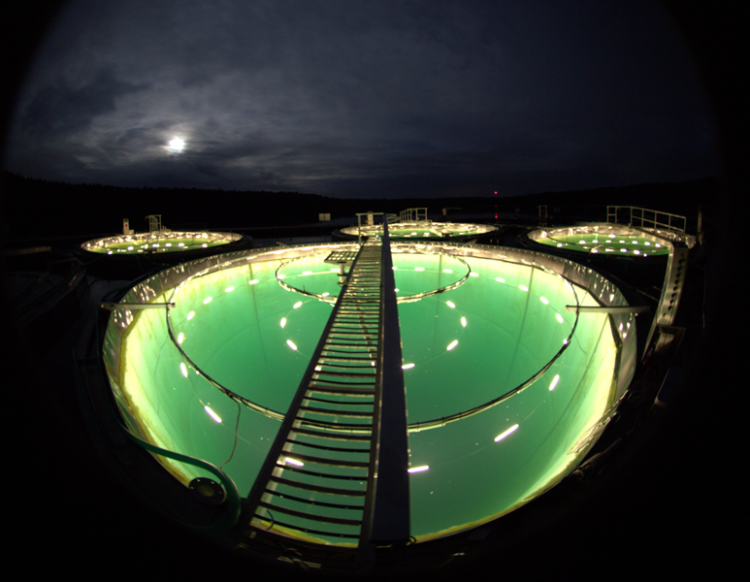
LakeLab, an experimental set-up in Lake Stechlin, a deep, dark, lake north of Berlin, is the site of experiments to test the effects of skyglow on the movement of zooplankton. LakeLab consists of an array of 24 freshwater tubes stretching from the lake bed to its surface. In the night-pollution experiments, a special LED light system, installed just above the water surface, simulates skyglow. Normally, zooplankton hide in the depths during daytime to escape predation and rise to the surface at night to feed on algae. The German scientists will test whether the experimental setup (shown here in a long-exposure photograph) alters this behavior.
CREDIT: ANDREAS JECHOW (IGB/GFZ)
Tune out or turn off
The current explosion in research comes at a critical time. To reduce energy consumption, municipal authorities around the world are replacing older-style lights with LEDs. In 2011, LEDs accounted for just 9 percent of the global lighting market: by 2014 the figure had risen to 45 percent, and by 2020, it’s forecast to reach 69 percent. Ironically, the latest satellite data show that rather than benefiting from the savings LEDs bring, authorities are installing even more lighting.
Lighting designers and city planners like LEDs because they produce very bright, white, light. This also makes them more of a biological hazard. White LEDs emit light of all wavelengths, with a prominent peak in the blue region. “And we know that many biological processes are particularly sensitive to the shorter, blue wavelengths,” Gaston says.
But LEDs can be tuned to emit kinder light. For the past six years, Dutch ecologist Kamiel Spoelstra of the Netherlands Institute of Ecology in Wageningen, has been running a unique experiment to assess the long-term effects, on a wide range of species, of LEDs modified to emit light of different colors. At eight dark locations in Dutch nature reserves, he and his team installed rows of street lamps with different-colored LEDs programmed to be on from sunset to sunrise. Remote cameras and detectors and an army of citizen scientists have been collecting data on birds, bats, moths, mice and plants.
Ecologists know that it’s impossible to turn back the clock and restore the dark nights of old. But there are ways to improve the prospects for wildlife. LEDs, now regarded as part of the problem, could be part of the solution if they are not too bright and are tuned to minimize their ecological impact, says Longcore. That won’t be easy. “Most animals are sensitive to shorter wavelengths and plants are sensitive to longer ones, so there’s unlikely to be a solution to suit all species,” says Robert.
But choices — by planners, city authorities and individuals — are equally important. To cut costs, and under pressure from residents concerned about the effect of light on their own lives, some cities have already begun to dim or turn off lights for part of the night. And so what about wildlife? “If we are more careful about where and how we use lighting, we could dramatically reduce the problem, benefit economically and reduce carbon dioxide emissions,” says Gaston. “Ultimately, though, there will be times and places where we should avoid its use altogether.”




